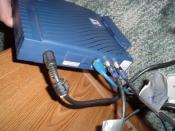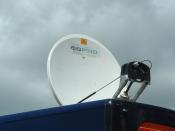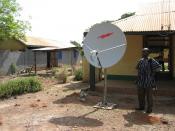INTRODUCTIONThere are approximately over 8,000 artificial objects orbiting around earth and about 2,500 of those are satellites. The public has used satellites as, relay systems to transmit and receive signals from anywhere on earth for over three decades now. Now with technology advancements in society and more remote areas requiring data connectivity, satellites are becoming more common in the world today. Satellite technology works by sending data to a satellite in orbit, which relays the signal back to an earth station providing connectivity among users. The satellite networks are designed to reach virtually everywhere in the world including the remote areas that don't have land based lines.
SATELLITESA satellite is an object that orbits in the sky and acts a repeater of a signal. First a source from a station transmits a data signal to the satellite, and then the satellite receives, processes, and then retransmits it to the receiving station.
Satellites act as a medium between these earth stations for the signal being transmitted. When the satellite retransmits the received signal, any receiving station in the coverage area can collect the signal. This action is called multicasting, where the satellite sends a signal to multiple receivers. (Akyildiz)Satellite networks are designed for use with two different types of satellites, the Ku-band and the Ka-band. The Ku-band satellites are a 3-meter dish that is commonly used for cable television broadcasting and operates on frequencies ranging from 12 to 18GHz. The Ka-band satellites use a 1-meter dish and are usually used for communication and operate on frequencies ranging from 18 to 40GHz.
(Akyildiz)The satellites altitude above the surface has a direct impact on it's performance and characteristics. First there is the low earth orbiting satellites, which use orbital altitudes of 750 to 1500 kilometers. This is the most common used satellite orbit...


